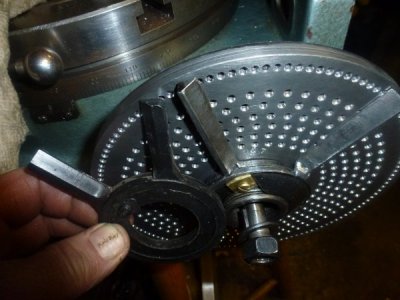-
Welcome back Guest! Did you know you can mentor other members here at H-M? If not, please check out our Relaunch of Hobby Machinist Mentoring Program!
You are using an out of date browser. It may not display this or other websites correctly.
You should upgrade or use an alternative browser.
You should upgrade or use an alternative browser.
Dividing head or rotary table with plates?
- Thread starter Larry42
- Start date
-
- Tags
- rotary tables
- Joined
- Mar 17, 2018
- Messages
- 1,400
I think I made that out of a hydraulic cylinder rod without any heat treating. The original part broke in half, so I would say it was too hard.Cat, how do you like your casting foundry, what do you cast?
Shooty, nice work on that part. What steel did you use? Heat treat?
If you can't make up your mind I would get a RT and use it to it's full potential, and then decide if you need a dividing head.
- Joined
- Feb 7, 2013
- Messages
- 2,489
Cat, how do you like your casting foundry, what do you cast?
Casting is great fun. I have made gear blanks made of aluminum and brass, Also have made flywheels and faceplates for disc sanders.
Also have made bearing blocks and also pistons. I plan to move my casting operation to my new shop area this spring. One is only
limited by his imagination. This type of operation generates a lot of heat and somewhat hazardous in my garage shop. It's moving to
my new all metal building.
This is one of my more elaborate builds. The two gear sets on the top of this photo were made from castings.
The gear housings were made with wood patterns using green sand technique. These are the new change gears
for my Springfield lathe that was missing the 1-1 and 2-1 ratios for various feeds and speeds.
- Joined
- Feb 7, 2013
- Messages
- 2,489
Nice work.
Did you turn your rotary table 7.2 degrees, make a cut, turn 7.2 degrees.......????
That is that one would do to make a 50 tooth gear. I used a dividing plate on the RT crank for accuracy.

This is a home made dividing head plate I use on my rotary table. The part in my hand is factory
plastic and the one on the plate I made of steel, way better...
- Joined
- Feb 7, 2013
- Messages
- 2,489
I was picturing the method I described. When you got to the 48th or 49th cut, hmmmm.
It would be off.
Your method is much better.
On a 90 to 1 rotary table, 1 rotation of the crank is 4 degrees. So you make one full rotation plus the amount of holes
needed on the plate to advance 3.2 more degrees.
- Joined
- Mar 26, 2018
- Messages
- 8,410
I recently purchased a very nice old used 10" rotary table. I have a 4" Bison chuck that went through the fire but, with a lot of work, it came out very good.
I'll never use it in a lathe other than slow speed.
I thought it would be perfect for the RT.
On my want list, is a universal dividing head with tail stock.
The list is long.
I admire your abilities, that part you made for your mill is great!!
I'll never use it in a lathe other than slow speed.
I thought it would be perfect for the RT.
On my want list, is a universal dividing head with tail stock.
The list is long.
I admire your abilities, that part you made for your mill is great!!
- Joined
- Mar 17, 2018
- Messages
- 1,400
Yes, that is exactly what I did. The first and last tooth was undetectable when it was finished.Nice work.
Did you turn your rotary table 7.2 degrees, make a cut, turn 7.2 degrees.......????

